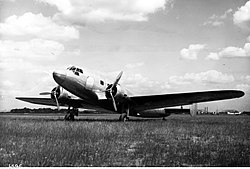PZL.44 Wicher
| PZL.44 Wicher | |
|---|---|
 Prototype PZL Wicher |
|
| Type: | Airliner |
| Design country: | |
| Manufacturer: | |
| First flight: |
March 20, 1938 |
| Number of pieces: |
1 |
The PZL.44 Wicher was a twin-engine commercial and transport aircraft produced by the Polish aircraft manufacturer Państwowe Zakłady Lotnicze (PZL).
history
At the end of 1935, the Polish Ministry of Transport instructed PZL to carry out studies for a Douglas DC-2- based airliner that could replace the outdated Fokker F-VII b / 3m . It was supposed to transport 14 passengers, use two 850 hp Wright Cyclones as a drive and go into series production in 1938. The PZL.44 Wicher (German: Sturm) presented as a result was smaller but heavier than the DC-2. As a result, the wing loading compared to the DC-2 was significantly higher, the cruising speed was slightly lower and the range was greater.
The responsibility for the construction of the Wicher lay with Wsiewołod Jakimiuk, who would later become known as the chief designer of De Havilland Canada . During the Wicher's development period, LOT procured a fleet of Lockheed 10 Electra and Lockheed 14 aircraft and showed little inclination to procure Polish-made aircraft. One reason was the expected high price of the PZL.44 due to the small volume of production.
The first flight took place at the end of March 1938 and at the end of the year the PZL.44 went to LOT for testing, which lasted until March 1939. The aircraft was then returned to PZL to make some improvements. In April 1939 the aircraft received the registration number SP-WHR and line test flights began. However, there were some shortcomings and the expected flight performance was not achieved. After further modifications and resumption of scheduled flights, no decision was made about series production when the German army marched into Poland. Shortly after the start of the war, the Wicher was flown to the Soviet Union by the pilot Klisz, who worked for LOT.
Ultimately, the PZL.44 was a modern and contemporary design, but it came too late to be successful. Air traffic, which developed rapidly in the 1930s, required large aircraft very quickly. The DC-2, with which the PZL.44 was to compete, was first flown on May 11, 1934 and was an important milestone in aviation history, but it was quickly developed into the DC-3 with twice the number of passengers. The successful DC-3 flew for the first time on December 17, 1935, long before the PZL.44 and only a year and a half after the DC-2. In 1939 it became very clear that the PZL.44 would not become a real competitor to the DC-2, as it had been in production long before that (its production was discontinued in 1937 before the PZL.44's first flight in favor of the DC-3) the more economical DC-3 was replaced.
construction
The PZL.44 was a two -engine low-wing aircraft in all-metal construction with a double vertical tail. The wings had a box spar and fabric-covered ailerons. The ailerons and flaps went over the entire trailing edge of the wing. The half-shell design of the hull had an oval cross-section. Interestingly, the top of the fuselage was lined with plywood. The landing gear including the tail wheel was fully retractable. The crew entrance was on the front left, and the passengers boarded on the left behind.
Technical specifications
| Parameter | Data |
|---|---|
| crew | 4th |
| Passengers | 14th |
| length | 18.47 m |
| span | 23.83 m |
| Wing area | 75.0 m² |
| Empty mass | 6000 kg |
| Takeoff mass | 9270 kg |
| Top speed | 358 km / h |
| Cruising speed | 278 km / h |
| Service ceiling | 6850 m |
| Range | 1830 km |
| Engines | 2 × nine-cylinder radial engine Wright GR-1820-G2 Cyclone with 850 PS (625 kW) each |
literature
- John Stroud: Wings of Peace - Polish Transports . In: Airplane Monthly, June 1991, pp. 368-375
Web links
Individual evidence
- ^ John Stroud, Wings of Peace , p. 374
